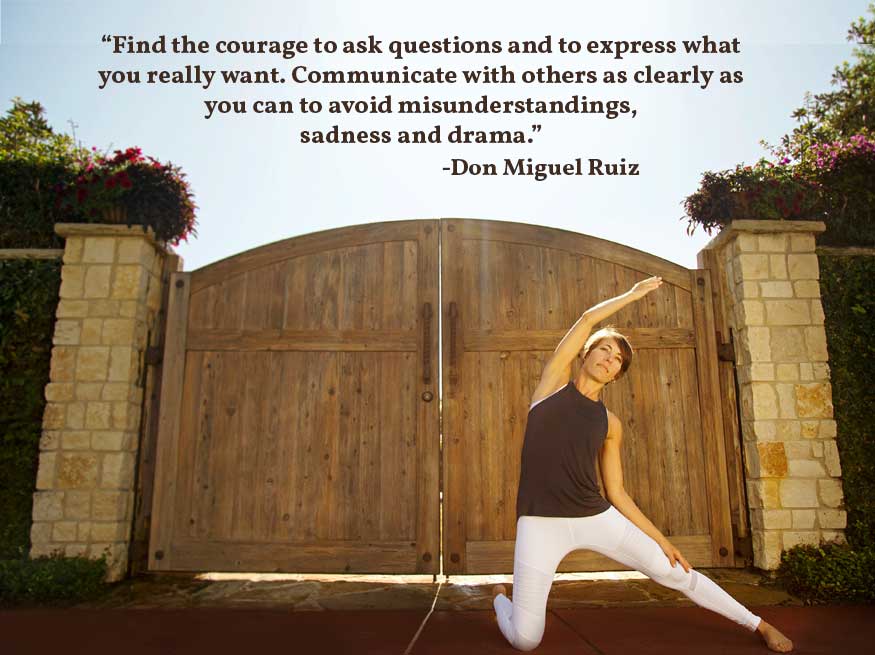 There are many agreements you make as a yoga teacher–some written, some verbal, and many unspoken. When you bring those agreements to light through clear communication, you increase trust with your students. You’ll also increase the level of engagement in your classes and influence the level of impact you have on them in a positive way. By understanding and using these agreements, you can also avoid simple missteps that would offset your efforts to cultivate meaningful relationships.
There are many agreements you make as a yoga teacher–some written, some verbal, and many unspoken. When you bring those agreements to light through clear communication, you increase trust with your students. You’ll also increase the level of engagement in your classes and influence the level of impact you have on them in a positive way. By understanding and using these agreements, you can also avoid simple missteps that would offset your efforts to cultivate meaningful relationships.
During a recent stint in Florida, I decided to attend a weekend yoga class with my neighbors. I had offered to drive and then realized that my husband, Steve, needed the car. The solution was to have Steve drop the three of us off at the 10 am class and pick us up at 11:30 when it ended.
Little did I know that the teacher would arrive late and that the class would run 30 minutes over the scheduled time slot. Without a visible clock in the studio to assess the time, I had no idea of this error until class had ended. Steve was upset that he had to wait a half an hour in the 90-degree heat outside. The neighbors also missed their scheduled lunch gathering with friends.
The above example indicates a breach in the written agreement of the advertised studio schedule. Not only did it dwindle my trust in the teacher, but it made me skeptical of how other components of that business were handled. Below, we discuss other common written agreements you find as a yoga teacher and you’ll be able to discover where you’re using these commitments to support your relationships. You can also note any weaknesses as a teacher and bolster up those loose ends before problems occur.
THE ROLE OF A YOGA PROFESSIONAL
Yoga is as much a science of moving the body as it is an art of living. As a yoga teacher, you not only guide students in improving their physical health, but you also show the possibilities of a better way of life.
In order to build our credibility as a yoga professional, it helps to practice that way of living yourself. Essentially, you’re walking the talk. You can do this by making decisions from an inner moral compass, as well as cultivating attributes of a leader (both on and off of the mat). On a practical level, you can also follow through with the agreements you make with your students.
WRITTEN AGREEMENTS
It’s easy for students to understand what you are providing as a yoga teacher through the written agreements you set forth before a practice even begins. Because yoga is a growing industry, you will often encounter many individuals who are new to the path. When you clarify these agreements in writing to both new and seasoned students, you set forth clear expectations within the relationship. The first five agreements cover these.
UNSPOKEN AGREEMENTS
Unlike some professions, such as fireman who take an oath to serve and protect, there is no official licencing or code of conduct for yoga professionals. Despite this loose arrangement of yoga ethics in the community today, there are common, unspoken agreements that you tend to make as a yoga teacher. The last five of these agreements are ones that can be communicated with your students–whether in written or verbal form–to further enhance student faith in their relationship with you.
(1) CODE OF CONDUCT
 What is it?
What is it?
A code of conduct is a set of social norms or proper practices within the yoga community. This can include general studio etiquette along with any specific tips for students to be successful in your environment.
We suggest you promote your code of conduct in the following ways:
- First and foremost, create a code of conduct for your teaching. Even if you teach only with private clients outside of a communal setting, write a clear code of expectations for your business.
- Post this code of conduct in places where it will be easily visible in your teaching space. This could look like a nicely-framed piece at the check-in station of your studio or on the bathroom walls where they won’t be missed.
- Post your code of conduct on your website
- Share this code of conduct immediately with new students. This could be a handout they receive during their first visit, and possibly get emailed when they sign up for class packages.
Photo Credit: James Balensiefen
(2) CODE OF ETHICS
What is it?
While a code of conduct explains procedures at your location, or what to expect during a yoga class, a code of ethics defines the values behind those procedures. This code of ethics also outlines a clear vision for the services you provide.
How to benefit from a code of ethics?
We show you how to create a code of ethics for your business or studio in some simple steps. When you do this, we suggest posting it in similar places for students and clients to visibly see. It can also be beneficial to have teaching staff sign your code of ethics to ensure your entire team is on the same page and serving the community with collective goals.
(3) CLASS SCHEDULE AND DESCRIPTION
What is it?
Each location that offers yoga classes provides a schedule of what days and times yoga classes are offered to the public. Most of these classes are accompanied by a description of the class level, style, and benefits.
How to build trust with your students using this tool?
- Notify students when class schedules are about to change. For example, you could change your schedule quarterly, and you might send out a reminder email to your community that the schedule is about to change (even if you don’t have all of the details in place). Then, when the posted changes do take place, you can send out another update with the specifics. This allows the students to feel included and prepared to make changes in their own lives in order to still take classes that keep them healthy and vibrant.
- Ensure that you, and your teachers, are actually teaching the kind of class that is advertised. While many class structures allow for drop-ins and new students, you may have to alter your sequence slightly to meet the needs of the group present. Yet you can still teach to the general style and ability of the described class as best as possible. Most importantly, don’t feel pressure to always make classes harder, or more rigorous, to prove your skills as a teacher. This hinders your professionalism–it doesn’t enhance it!
- Start and end on time. When you start a yoga class on time, you set the tone for what is to come in your class. And, since endings are what students remember most, you can leave a positive impression by finishing class at the scheduled end time. In both cases, you honor your students by recognizing the value of their time.

Photo Credit: Casey Brooke Photography
(4) TEACHER BIO AND PICTURE
What are they?
The phrase “a picture is worth a thousand words” is highly relevant with yoga teacher photographs. Essentially, a clear and professional picture on your website, social media channels, and other marketing material is the first way you get to make a good first impression with your students. Your biography is what lists your credentials and describes your teaching style to those very same people. When they are honest and inviting, you can build a bond of confidence with others before you even meet them.
How to build credibility with your photo and biography:
- Get a professional photo taken of you for your business. We highly recommend taking some headshot photos, so people can get a good look at your beautiful face. Then, also take some of you in yoga poses. This will verify that you are actually practicing what you are teaching.
- Create consistency on your website. If you run a studio, consider having similar professional photos of each teacher at your center. Or, if you want to include a variety of photos, format them in a similar color scheme and style to create harmony on your site. The cohesion you create online activates a subconscious level of trust and welcomes new students to your space. And, it reflects a high level of professionalism for your yoga business.
- Keep your biography simple, relevant, and truthful. When you come across in a personable, yet knowledgeable way, people want to get to know you. And, when you can back up your credentials with actual wisdom and experience, you further build a the honorable attraction with those in your community.
(5) MEDICAL DISCLAIMER
What is it?
A medical disclaimer is a way for you to minimize legal risk when offering health advice to students. Essentially, it’s a way for you to maintain your role as a yoga teacher without crossing the lines of other health professionals such as doctors, physical therapists, and psychologists.
How to maintain your boundaries with a medical disclaimer:
- Post a written disclaimer on your website and contract that students sign at your space. This will limit some of the liability should something unfortunate occur.
- Encourage your students to work with a team of professionals. Each student has experienced a variety of relationships and circumstances that could have caused trauma. And since emotional issues to arise in yoga, it can be helpful to have each student supported by other mental health professionals. Similarly, yoga cultivates changes in the body, and works with bodies that do have current injuries. By passing students on to other specialists, you get yourself off of the hook to be all things to each person. In your willingness to work with others, you demonstrate that you want the best for your students.
- When you don’t have a solution for a student, clearly refer them to another professional or another yoga teacher. This release of ego or attachment further exemplifies your desire for the student’s wellbeing. This might not have an immediate or monetary benefit, but it increases your integrity exponentially.

Photo Credit: Hudson Hintze
(6) A SAFE LEARNING SPACE
What is it?
The yoga room, or space in which yoga is practiced, is a protected environment in which new skills can be effectively absorbed.
How can you honor this agreement?
- Keep your teaching space clean (and use non-toxic chemicals to do so)
- Supply your students with appropriate props and materials to suit their individual needs
- Limit your class sizes so that each student gets personal attention and physical safety is not at risk.
- Hire assistants to help a lead teacher for larger class sizes
(7) STUDENT RIGHTS
What are they?
Yoga is a co-creative experience between both teacher and student. While teachers might be in a leading role, it is just as important for a student to know their rights and responsibilities in the yoga environment. This will not only help them stay safe, but it can help them create a path to a sustainable practice of their own over time.
Students always have the right to:
- Request the teacher not adjust them
- Ask the teacher to modify how they are being adjusted
- Remain honest with themselves and their teacher
- Speak up if any boundaries are being crossed
- Bring their attention into the moment (leaving friends, family, career, etc off the mat for the time being)
- Do their best without judgment
Ways you can remind students of their rights?
- Announce them in class
- Send out reminder emails to students about their role in the learning process
- Ask questions of your students in a class to ensure you are not overstepping boundaries and confirm that you are in agreement with those around you.

Photo Credit: Ember and Earth Photography
(8) PERMISSION TO TOUCH
What is this?
Physical adjustments in class are one tool in which yoga teachers can inform students of proper alignment as well as help them explore a different dimension of a posture. While this is a common teaching technique today, there are no written agreements about how this should take place. Thus, the more you communicate with students should you utilize this teaching practice, the more reliable you will be in the eyes of your students.
How to honor this unspoken agreement?
ALWAYS ask a student if you can touch them BEFORE adjusting them (not during or after your hands are on their body). Even students you have known for a long time might have days where they want to explore their practice alone. Assuming they are okay with you touching them breaks the bonds of trust in a nanosecond. And, by asking permission, you remind them of their right to accept or decline the contact.
(9) GOAL OF INDEPENDENCE
What is this?
Without being told to do so, the role of the yoga instructor is to teach in a way that leads students to a self-sufficient and autonomous practice. What does autonomous mean? It means an action one can take on their own. In a teaching setting, this means that you help students create a practice they could do on their own. It also means you teach in a way students will then be confident to go to other teachers and studios to take classes, too.
How do work toward this end goal?
Instead of just flowing through postures and sequences, take time to break down the alignment and principles of such poses. Explain what parts of the body are being used. Speak about the yoga practice in both English and Sanskrit. And, encourage students to use their own internal reference point throughout their learning process. This will keep them empowered in the process, so that when they are ready to try something new, they’ll feel confident to do so.

Photo Credit: David Macru
(10) ADMIT YOUR LIMITATIONS
What does this mean?
There are two powerful phrases in the English language: “I’m sorry,” and “I don’t know.” In a world that wants or expects you to have all of the answers, it can be easy to eliminate these words from your vocabulary. This is even true in the yoga community where you want to be seen as a spiritual leader. Yet, when you acknowledge your limitations and errors, you build trust with those around you. If you make a mistake, or speak harshly, then apologize. If a student asks you a question for which you have no answer, then admit it.
This level of vulnerability saves time and energy from putting on airs, or pretending that you are something you are not. Ironically, it also demonstrates your courage when you can abandon your pride and ego for the good of someone else. You also prevent future hurt and resentment in accepting your humanness in this way.
PUTTING IT TOGETHER
The above 10 agreements represent just a few written, verbal, and unspoken contracts you make as a yoga teacher. When you take time to understand these agreements, and communicate them clearly to your students, trust increases. You also set yourself up as a leader through your transparency and honesty.
We offer examples of how you can use simple tactics like a code of conduct and code of ethics to align your community around a common goal. We’d love to hear how you implement these agreements, and others, into your own yoga business. Please share them with us below, or email them our way.
Then, next week we’ll cover some aspects of meditation, as well as great yin yoga poses to open up the hips.








Leave A Comment